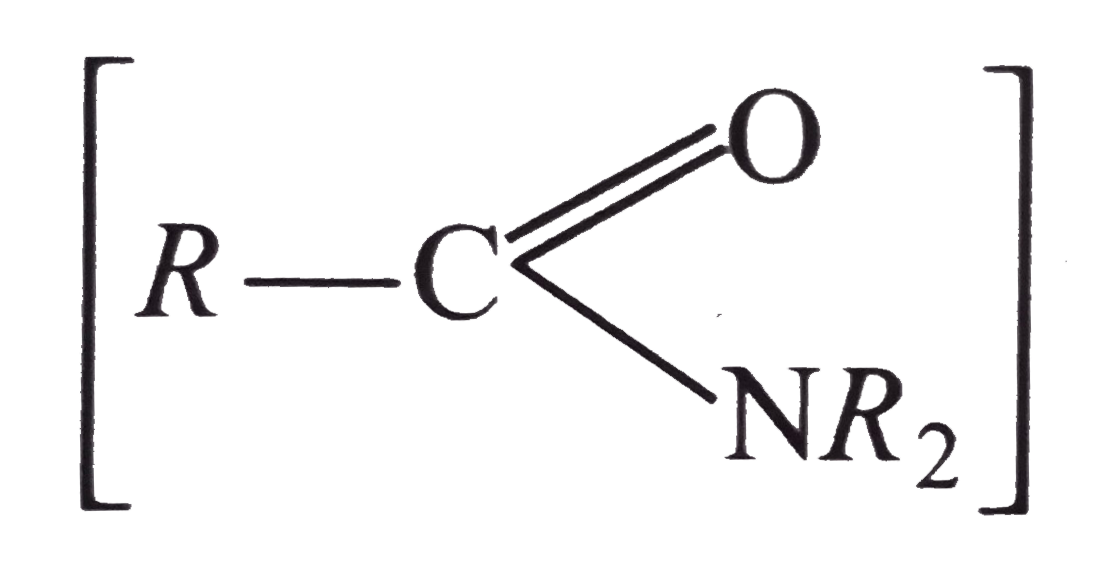Reaction is said
Hofmann bromamide reaction
Schmidt reaction
Curtius reaction
Beckmann reaction
The correct Answer is:A
To determine the name of the reaction given by the equation:
RCONH2+4NaOH+Br2→RNH2+2NaBr+Na2CO3+2H2O
we will analyze the components and the nature of the reaction step by step.
Step 1: Identify the Reactants
The reactants in the equation are:
- RCONH₂ (a primary amide)
- 4 NaOH (sodium hydroxide)
- Br₂ (bromine)
Step 2: Analyze the Reaction Conditions
The reaction involves a primary amide reacting with sodium hydroxide and bromine. The presence of sodium hydroxide suggests that the reaction is likely to involve a hydrolysis step, while bromine indicates a halogenation process.
Step 3: Identify the Products
The products of the reaction are:
- RNH₂ (a primary amine)
- 2 NaBr (sodium bromide)
- Na₂CO₃ (sodium carbonate)
- 2 H₂O (water)
Step 4: Recognize the Type of Reaction
This reaction is characteristic of the Hofmann degradation (or Hofmann bromamide reaction). In this reaction, a primary amide is converted into a primary amine with the loss of one carbon atom. The reaction also produces sodium bromide and sodium carbonate as by-products.
Step 5: Conclusion
Based on the analysis, the reaction can be classified as the Hofmann Bromamide Reaction.
Final Answer
The reaction is called the Hofmann Bromamide Reaction.
---
The reactants in the equation are:
- RCONH₂ (a primary amide)
- 4 NaOH (sodium hydroxide)
- Br₂ (bromine)
The reaction involves a primary amide reacting with sodium hydroxide and bromine. The presence of sodium hydroxide suggests that the reaction is likely to involve a hydrolysis step, while bromine indicates a halogenation process.
The products of the reaction are:
- RNH₂ (a primary amine)
- 2 NaBr (sodium bromide)
- Na₂CO₃ (sodium carbonate)
- 2 H₂O (water)
This reaction is characteristic of the Hofmann degradation (or Hofmann bromamide reaction). In this reaction, a primary amide is converted into a primary amine with the loss of one carbon atom. The reaction also produces sodium bromide and sodium carbonate as by-products.
Based on the analysis, the reaction can be classified as the Hofmann Bromamide Reaction.
The reaction is called the Hofmann Bromamide Reaction.
Topper's Solved these Questions
Similar Questions
Amides with no substitution on nitrogen react with tht: solution of bromine or chlorine in NaOH or KOH to yield aminei through a reaction called as Hofmann's degradation.
R−O∣∣C−NH2+Br2+4NaOHH2O−−→R−NH2+2NaBr+Na2CO3+2H2O
Amides can be reduced to amines having same number of carbon atoms
R−O∣∣C−NH2−[H]−−−→LiAlH4R−CH2−NH2
Benzamide when treated with Br2 in presence of NaOH gives aniline.
View SolutionAmides with no substitution on nitrogen react with tht: solution of bromine or chlorine in NaOH or KOH to yield aminei through a reaction called as Hofmann's degradation.
R−O∣∣C−NH2+Br2+4NaOHH2O−−→R−NH2+2NaBr+Na2CO3+2H2O
Amides can be reduced to amines having same number of carbon atoms
R−O∣∣C−NH2−[H]−−−→LiAlH4R−CH2−NH2
Carbon dioxide gas is released in above mentioned reaction
View Solution
Knowledge Check
RCONH2+4NaOH+Br2→RNH2+2NaBr+Na2CO3+2H2O Reaction is said
AHofmann bromamide reactionBSchmidt reactionCCurtius reactionDBeckmann reactionNa2CO3.10H2O is
AWashing sodaBBaking sodaCBleaching powderDSlaked limeR−O∣∣C−NH2+xNaOH+Br2→R−NH2+2NaBr+Na2CO3+H2O
Number of moles of NaOH used in above Hoffmann bromamide reaction is :A3B4C5D6
Amides with no substitution on nitrogen react with tht: solution of bromine or chlorine in NaOH or KOH to yield aminei through a reaction called as Hofmann's degradation.
R−O∣∣C−NH2+Br2+4NaOHH2O−−→R−NH2+2NaBr+Na2CO3+2H2O
Amides can be reduced to amines having same number of carbon atoms
R−O∣∣C−NH2−[H]−−−→LiAlH4R−CH2−NH2
 will undergo Hofmann's degradation.
will undergo Hofmann's degradation.
View SolutionAmides with no substitution on nitrogen react with tht: solution of bromine or chlorine in NaOH or KOH to yield aminei through a reaction called as Hofmann's degradation.
R−O∣∣C−NH2+Br2+4NaOHH2O−−→R−NH2+2NaBr+Na2CO3+2H2O
Amides can be reduced to amines having same number of carbon atoms
R−O∣∣C−NH2−[H]−−−→LiAlH4R−CH2−NH2
N-Methyl aniline can be obtained by using Hofmann's degradation.
View SolutionAmides with no substitution on nitrogen react with tht: solution of bromine or chlorine in NaOH or KOH to yield aminei through a reaction called as Hofmann's degradation.
R−O∣∣C−NH2+Br2+4NaOHH2O−−→R−NH2+2NaBr+Na2CO3+2H2O
Amides can be reduced to amines having same number of carbon atoms
R−O∣∣C−NH2−[H]−−−→LiAlH4R−CH2−NH2
Iso-cyanates are formed as intermediate in the Hofmann's degradation.
View Solutionwhich one of the following reaction is not associated with the solvay process of manufacture of Na2CO3? (A) NaCl+NH4HCO3→ NaHCO3+NH4Cl
(B) 2NaOH+CO2 → Na2CO3+H2O
(C) 2NaHCO3→ Na2CO3+H2O+CO2
(D) NH3+H2CO3 → NH4HCO3
View SolutionNa2SO3+H2O2→Na2SO4+H2O, in reaction
View Solution
